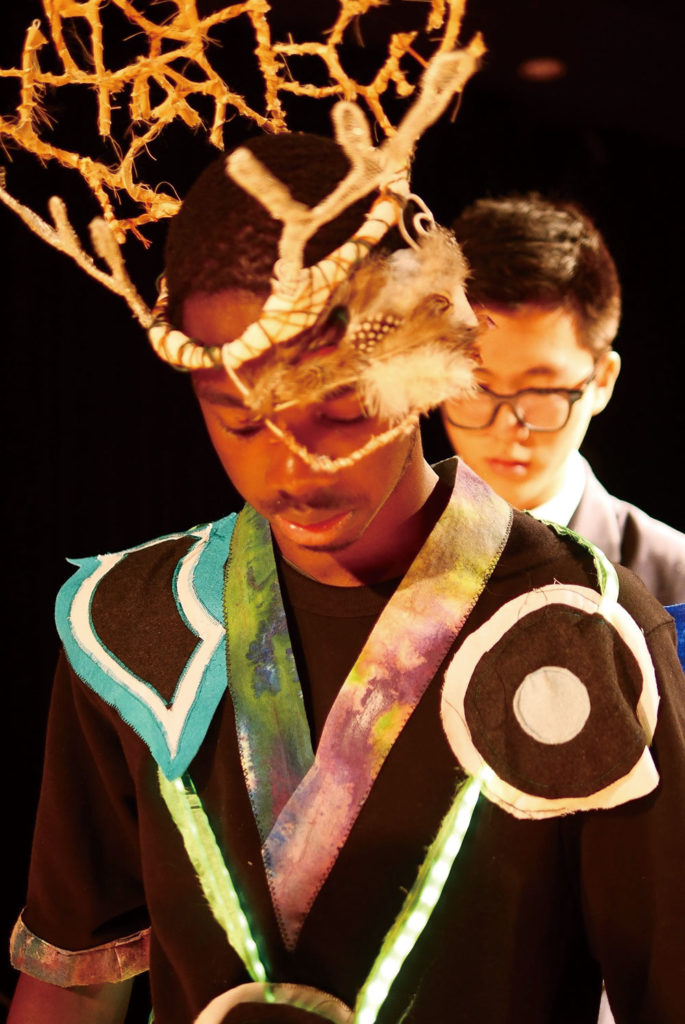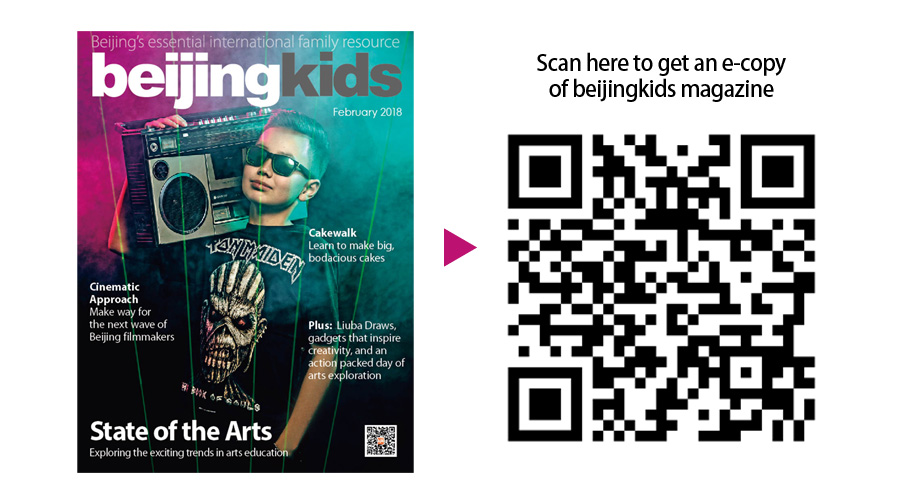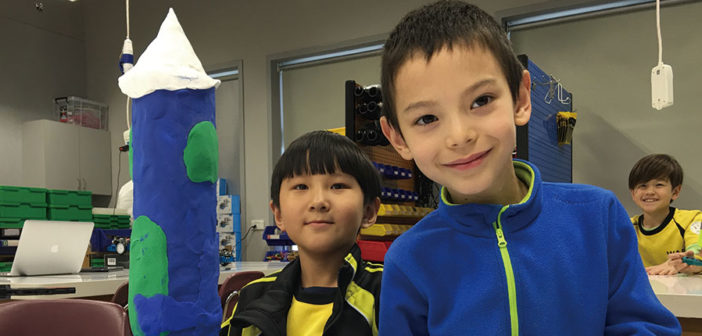We wrote last August about the innovation going on in Beijing classrooms. This progress, however, is not limited to what’s happening in areas such as individualized study or project-based learning, but also extends to what’s going on in the art class. This area of study has been embracing an array of new technologies and learning concepts, as it strives to remain relevant at a time where budget cuts at schools are often being made to subjects which are sometimes considered to be of less value to a student’s future.
Just as you’d find in a variety of museums and galleries around the world, the line between the arts and scientific exploration is blurring, as creatives begin implementing technology and new media into their areas of expression. You might have noticed that a trip to the museum is no longer just about paintings or sculptures, but also video, virtual reality, and even robotics. So it makes sense that the creative adoption of such things as basic electronics, design, or hacking would inevitably find its way to the current set of creative electives available to your child in primary, middle, or high school.
Though we hesitate to call some of these labs the new art class, there are plenty of similarities and chances for the student be creative, which makes us wonder about the potential for expression in addition to the learning side of the equation. While giving students an introduction to some of the foundational skills which might be required for life in the future, it does provide a similar service for engaging both sides of the brain, enhancing motor skills, and promoting creative problem-solving like your traditional art class.
We talked to Douglas Taylor from the Makerspace at the Western Academy of Beijing (WAB), and Joseph Steward and Ann Carmichael of Dulwich College Beijing (DCB), to find out how their opportunities for building and creative exploration were evolving to incorporate these new disciplines. We hope this gives you a better idea of how these schools are implementing these practices, along with how projects are being initiated, encouraged, and achieving some surprising results.
Taylor started off by telling us how areas of study like design and technology had been implemented into WAB’s middle and high schools and had become an important part of the curriculum. “They (high school and middle school students) actually do it as a class,” he explained. “They have specialist teachers, workshops, they have all that stuff, and it’s part of the curriculum. But, in the elementary school, we don’t have that. There are no specialist teachers, and making has been more something that you would do in your homeroom class, and the teacher usually doesn’t have the expertise or doesn’t have the space to actually do those kinds of projects in their homeroom.” This need is what encouraged WAB’s primary school to initiate their Makerspace. He continued: “What helped us to get the ball rolling was that we inherited a whole heap of Lego Technic from the High School that was no longer being used. So, we had all this, and it sort of got us started with how could we use that with what we were doing in the school.”

A majority of what is being done in the primary school Makerspace is the kids’ own projects. They come to the class with a wide variety of ideas for things they are interested in building or designing, ranging from simple contraptions to things that are endearingly more ambitious, yet beyond the skillsets of the teachers. This has become a significant component of what is known at WAB as Personal Inquiry Time, where the children are encouraged to dive deeper into a subject of study they are particularly keen on learning more about.
Taylor elaborates. “At the moment Personal Inquiry Time is still evolving, but most of the classes will work with their students on coming up with a plan on what it is that they want to do. Some are doing it with buddy classes where the younger students are working with older kids on a project. It varies how much they do it. Some classes do it once a week for two periods; some people do it for two periods at the end of the day throughout the week. It also comes down to the availability of the space.”
Just having access to these making facilities is revolutionary for kids of this age to use their hands and create objects that have purpose, or that can reinforce what students are learning in the classroom as they try to apply this knowledge into very creative real-world circumstances.
Taylor then broke down for us what he felt makes the Makerspace unique. “They start with a plan based on an idea that they’ve either seen or come up with themselves, and they follow through that process to an endpoint. So whether that’s a successful endpoint or a catapult that doesn’t work at all, or a car that doesn’t roll, that’s not really the point, but learning all of those skills that go into making that and learning how to follow that process I think is one of the most important things about a Makerspace. You don’t have to have robotics or Lego, you can have boxes, and junk and kids can still build something. It’s about turning an idea into a product.”
Items like primitive Lego catapults, giant semi-floatable wooden boats which can be remotely controlled with Arduino circuits, and experimental video game controllers using a melange of repurposed junk and even fruit, were just some of the interesting devices we saw displayed throughout the room.
It was amazing to learn how these creative spaces which encourage kids to build and design were being implemented at such an early stage of development, but how do these practices of making evolve and fuse with the areas of creative electives on both a primary and high school level? For this, we talked to Dulwich College Beijing (DCB), who have been rapidly developing their facilities to accommodate this more interdisciplinary approach to the arts.
In order for us to understand how much the “art class” has evolved from just drawing and painting, Junior School Head of Art, Ann Carmichael explained exactly what was happening creatively with their current batch of students and how the DCB curriculum strives to show how creative ideas can be used in all areas of study and not just the art room.
“Over the past few years, we have combined art and design into one subject, equipped the art rooms with a laser cutter, sewing machines, embroidery machines, a sublimation printer, and cameras, alongside the more traditional materials and equipment that you would expect to see in an art room. This curriculum has enabled us to explore a wider range of techniques and apply greater depth to our investigations within themes and projects, allowing students to always find something they can enjoy, develop, consolidate, and extend.“
There is plenty of room in these classes for students to combine subjects and work across disciplines through inquiry-driven study, Joseph Steward told us: “We aim to create cross-curricular projects for our students to allow them to see how learning in art and design is relevant to other subject areas. Recent examples of this have been our Key Stage 3 students exploring Chinese culture through art, and some of our students linked in with a Shakespeare drama production to create made-to-measure costumes. We are also currently developing graphic and packaging design projects which could link in with our technology department. Another potential project in the pipeline is linking in with our English and Humanities department to make animations and artwork to commemorate the centenary of WW1.”
Just how much creative freedom is given to these students, and what is the current role of the teacher in this new working environment? After all, with all of the academic requirements these students already have, room for much deviation from an already demanding curriculum with even more deadlines can make these courses an added area of stress. But they can also help in academic subjects in a variety of ways. Steward responded; “The teacher’s role is to facilitate the inquiry-based learning of students and provide structured guidance and feedback when necessary. There are also a lot of ‘Approaches to Learning’ skills we teach in art, such as enabling students to communicate visually, collaborate in learning with their peers, and managing their time to avoid last minute rushing at the end. We teach them how to think creatively, to come up with their own ideas and concepts instead of simply telling them what to do. Feedback from students is always positive, and they often tell us this way of thinking helps with their higher-order thinking skills in other subject areas.“
The arts might to some seem like just fun and games, but there are definite applicable benefits of these skills. Within the confines of very binary mindsets critiquing these areas of study, this won’t always be recognized, and this presents a definite challenge for those who seek to encourage and develop the role of these art-focused classes of the future. Ann Carmichael said: “The biggest challenge we face is the perception of art being a lesser subject within the curriculum. Often it is valued less and less, cut from curriculums and schools when budget cuts arise. Students have less access to the arts at home due to a greater focus on other areas. Long term, we would like students to be more confident in their own abilities, to not be afraid to make a mistake, and to understand mistakes are valuable. To use art and design to express themselves and their world, to use it as a communication tool, or even as a way to block out the rest of world and have time for them!”
This is an enormous challenge for arts learning in the 21st century, but from what we’ve learned there is no lack of interest from the students or the passionate educators in charge of leading these young minds. If the creative projects consisting of both utilitarian objects from the Makerspace at WAB’s primary school, and awesome works of cross-disciplinary art made by Dulwich College Beijing’s students, are any indication, then we feel like it’s safe to say that the state of the arts is alive and well in the capital and there is a wealth of creativity to be experienced on the horizon.

Photos: Kipp Whittaker; courtesy of WAB and DCB
This article appeared on p54-56 of beijingkids February 2018 issue.



